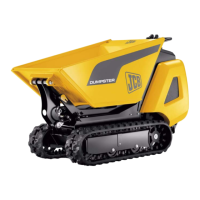Section C - Electrics
Battery
Battery Checks
C-6 C-6
9803/9570-4
Checking the Electrolyte Level - up to
machine no. 1360211
Maintenance free batteries used in normal temperate
climate applications should not need topping up. However,
in certain conditions (such as prolonged operation at
tropical temperatures or if the alternator overcharges) the
electrolyte level should be checked as described below.
1 Park the vehicle on firm level ground. Stop the engine
and remove the ignition key.
2 Remove the engine cover (if fitted) K Engine
Cover ( T B-1) and move the engine back on its
mounting to gain access K Engine Mounting ( T K-3).
3 Remove the battery assembly K
Battery Removal
and Replacement ( T C-7).
4 Remove the battery cell cover(s).
5 Make sure the level in each cell is 0.250 in (6 mm)
above the plates. If necessary, top up with distilled
water. Refit the battery cell cover(s).
!MWARNING
Do not top the battery up with acid. The electrolyte
could boil out and burn you.
2-3-4-6
6 Refit the battery to the machine.
7 Move the engine back to its correct position K Engine
Mounting ( T K-3) and refit the engine cover K Engine
Cover ( T B-1).
Checking the Electrolyte Level - from
machine no. 1360212
Maintenance free batteries used in normal temperate
climate applications should not need topping up. However,
in certain conditions (such as prolonged operation at
tropical temperatures or if the alternator overcharges) the
electrolyte level should be checked as described below.
1 Park the vehicle on firm level ground. Raise the skip
and fit the safety strut to the lift ram K Safety
Strut ( T 3-10). Stop the engine and remove the
ignition key.
2 Unscrew three bolts C and remove the main battery
cover D.
3 Remove the battery cell cover(s).
4 Make sure the level in each cell is 0.250 in (6 mm)
above the plates. If necessary, top up with distilled
water. Refit the battery cell cover(s).
!MWARNING
Do not top the battery up with acid. The electrolyte
could boil out and burn you.
2-3-4-6
5 Refit the main battery cover D.
6 Remove the ram safety strut and lower the skip.
Fig 2.
A
B
manualequipospesados@gmail.commanualequipospesados@gmail.com

